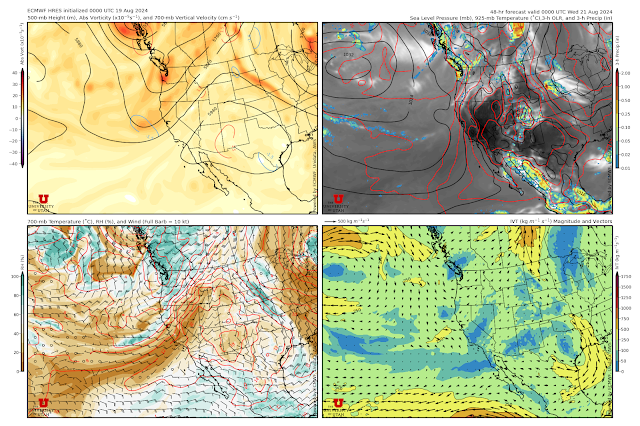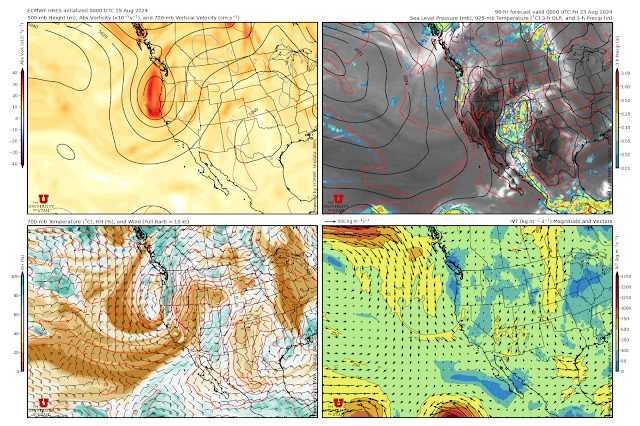 |
| Aqua/Modis Satelite Image of the Great Salt Lake on 4 Aug 2024 |
It is not uncommon to see reports of recent or long-term trends in the Great Salt Lake characteristics based on lake elevation. This is a quantity that is measured at three locations, two with a fairly long record. The first is Saltair in the south arm of the great Salt Lake. The second is Saline in the north arm.
While convenient, they often differ by a decent amount. This is because the lake is separated by a rock fill railroad causeway which limits the transfer of water between the two halves. This results in differences in lake elevation (the south arm is typically higher), salinity (the north arm is saltier), and even color (see above; for an explanation see https://wildlife.utah.gov/gslep/about.html.)
However, with a little information about the lake bathymetry (i.e., the underwater terrain of the lake), one can take the elevations from Saltair and Saline, estimate the area and volume of each half of the lake, and combine them into a total area and volume for the lake. Thanks to work by Utah State University and the USGS, tables to convert from elevation to area and volume are available at https://pubs.usgs.gov/of/2005/1327/PDF/OFR2005-1327.pdf and https://pubs.usgs.gov/of/2006/1359/PDF/ofr2006-1359.pdf, respectively. These are based on 1/2 foot lake elevation intervals.
Based on recent readings rounded to the nearest half foot, I thought I would look at changes from August 2022, when the lake was approaching its historical minimum elevation to August 2024, the summer after two above average snowfall years. Here's what I got.
Aug 2022
Saltair/Saline Elevations: 4189.6/4189.4 ft
Estimated Lake Area: 605,242 acres
Estimated Lake Volume: 7,419,322 acre-feet
Aug 2022
Saltair/Saline Elevations: 4193.6/4191.8 ft
Estimated Lake Area: 649,320 acres
Estimated Lake Volume: 9,528,374 acre-feet
So, in this two year period, the lake area has increased about 7% and the volume has increased about 28%.
Feel free to pull the numbers and check my math. However, one can see why the the former has gone up more slowly as a percentage based on the graph below which shows the volume and area as a function of lake elevation in the south arm (also known as Gilbert Bay). Note that the slope of the area curve becomes =greater above about 4194 feet. Basically, the lake "bathtub" has steep walls up to 4195 feet, so a given volume of water increases the area less than at higher elevations where the "bathtub" walls are more gentle.
I've used the words "estimated" above because lake bathymetry does have some uncertainties, I'm rounding off noisy lake-elevation data, etc.
If someone knows of a website that provides data on area and volume calculated based on the elevation data in the two halves of the lake, please share in the comments below. I think that would be extremely useful to have updated monthly to better understand what is happening in each half and for the lake as a whole.









